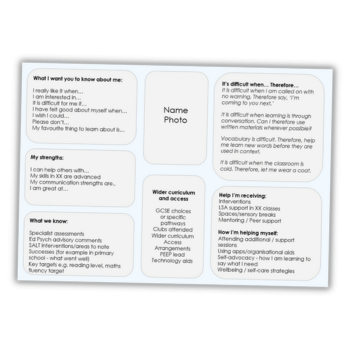Classroom environments – Shape your learning space like a conductor

If we want to see genuine engagement and learning taking place in the classroom, let’s start by reshaping the space itself, says Ed Carlin…

- by Ed Carlin
- Deputy headteacher at a Scottish secondary school

I remember how, shortly after I was promoted into middle leadership, the head of the school came to visit my classroom. He talked of how well he thought my interview went, and told me he’d been impressed by my education views and values.
What stood out to me the most in that conversation, however, was when he said, “Ed, it’s rather simple. Good education is like music.”
When my facial expression duly betrayed the curiosity he’d planned for, he went on to explain that it was all about timing and contribution. Every student in a class had a part to play, but they all needed a great conductor.
His observation has remained with me to this day. Highly effective teachers instinctively know to lead a classroom like a well-tuned orchestra, bringing out the best in each ‘musician’ while at the same time pulling their individual contributions together in perfect harmony.
Yet we can go further. If we can align our learning and teaching plans with our school’s broader climate, purpose and values, great learning will almost inevitably be the outcome.
Playing their part
Teachers must never forget that learning should be at the core of everything they do, regardless of topic. However, with the acquisition of skill and mastery of pedagogy comes the knowledge that individual pupils need to work with different resources, tools and learning styles.
Every member of an orchestra will play their instrument to the best of their respective abilities, but do so knowing that their contribution is vital for the collective piece to come together. In the same way, we all recognise how important it is that we differentiate the resources we deploy the classroom.
Yet I worry that for many, this process begins and ends with simply handing out worksheets, or setting tasks specifically designed for different levels of ability. It’s not that this is inherently wrong; more that it only represents one part of what should be a larger process of inclusion.
Groupings and work areas should be adapted to meet the needs of all learners. Different types of activities should be aligned with visual, audio and kinaesthetic learning styles. The room should be abuzz with different contributions taking shape and being added to the overall masterpiece.
Readers may find the notion a little eccentric, or even controversial, but I truly believe that having pupils sat in rows of desks for prolonged periods of time should be utterly frowned upon. Categorically.
Much as we wouldn’t stand for pupils being asked to remain completely silent while working on textbooks for 50 to 60 minutes, the way in which they’re seated (or heaven forbid, standing) should be flexible and of their
own choosing.
Let’s think outside the box when it comes to classroom layout. Are individual desks even needed at all? Soft, comfortable seating and work areas will likely resemble something much more akin to the modern workplace.
In recent years, many employers and CEOs have enthusiastically embraced the need to diversify and innovate when it comes to improving working environments, and recognised the positive impact on staff productivity this can have. Shouldn’t we be looking to do the same in our schools?
Group performance
Consider the ‘Circle Time’ strategy often used in primary classrooms. This highly practical way of gathering children together to listen to stories exerts a magnetic effect that could be utilised in many secondary learning scenarios.
Simply put, children enjoy the fact that circle time lets them out of their class seats and build trust with their teacher and fellow classmates, before benefiting from the literacy outcomes produced by the simple act of reading a text and discussing it afterwards.
Could we not continue something practical like this well into the secondary experience? Pupils could perhaps be gathered into groups to watch, read, share and learn. The teacher could then circle the different groups, helping to stretch their ideas and thinking, but with the pupils ultimately working together and building on each other’s knowledge and understanding.
Now, many teachers reading this may well respond with ‘That’s just groupwork – we do that all the time.’ However, what I’m suggesting is perhaps a little more radical – that we make this the default arrangement.
Simple psychology
When it comes down to it, what purpose does having rows of desks and seats in a typically 100m square classroom actually serve anymore? Continuing to have pupils sit in designated seats for long periods of time seems ludicrous.
Instead, embracing the simple psychology of handing the space over to our learners, for them to arrange in whatever way they feel appropriate, means they get to feel that they’re part of a team, with a certain level of responsibility for leading and managing themselves.
You may, of course, ask ‘What about those pupils who will undermine and disrupt learning as a result of their inability to manage such flexibility and autonomy?’ Well, this is where all the usual clarity in terms of expectations and boundaries comes into play. Pupils tend to know what’s acceptable in a social context. The usual suite of reminders and, when necessary, consequences should be enough to keep their behaviour in line.
If behaviour still breaks down with that in place, it would be unwise to immediately ascribe this to any increased freedom or flexibility in terms of your classroom arrangement. Young people can always be relied upon to find themselves distracted, and sometimes even disruptive when surrounded by their peers – something which can just as easily be said in relation to many other classroom settings and specific layouts.
I’ve always supported the idea of decoupling the management of negative behaviour from courageous and innovative classroom practice, since one should never prevent the other from happening.
Be the change
To any teachers or school leaders who may be reading this, I would urge you to be the change that you wish to see in the success of your pupils. Dare to think differently, and design your classrooms as forward-thinking, inspiring and work-ready environments.
The classroom should be a place where your pupils can all take ownership of what they’re studying, and learn the essential skills needed to eventually learn and manage themselves. If educators are the architects of learning, then now is the time for us to act on our initiative and open out our learning spaces, so that they can provide young people with the environment necessary for them to thrive and succeed.
Ed Carlin is a deputy headteacher at a Scottish secondary school, having worked in education for 15 years and held teaching roles at schools in Northern Ireland and England







